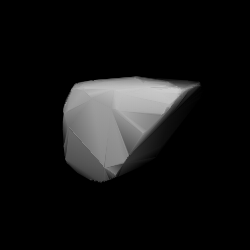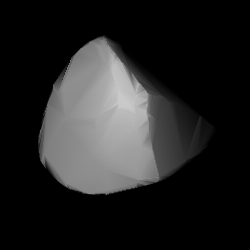Related Research Articles
51826 Kalpanachawla (provisional designation 2001 OB34) is an Eoan asteroid in the outer region of the asteroid belt, approximately 7 kilometers in diameter. It was discovered on 19 July 2001, by astronomers of the Near-Earth Asteroid Tracking program at Palomar Observatory in California, United States. The asteroid was named for Indo-American astronaut and mission specialist Kalpana Chawla, who died in the Space Shuttle Columbia disaster.
2807 Karl Marx, provisional designation 1969 TH6, is a carbonaceous Dorian asteroid from the central region of the asteroid belt, approximately 17 kilometers in diameter. It was discovered on 15 October 1969, by Russian astronomer Lyudmila Chernykh at the Crimean Astrophysical Observatory in Nauchnyj on the Crimean peninsula. The asteroid was later named for the German philosopher Karl Marx.
46610 Bésixdouze (French pronunciation:[be.sis.duːz]; provisional designation 1993 TQ1) is a bright background asteroid from the inner regions of the asteroid belt, approximately 2 kilometers in diameter. It was discovered on 15 October 1993, by Japanese amateur astronomers Kin Endate and Kazuro Watanabe at the Kitami Observatory in eastern Hokkaidō, Japan. The asteroid was named after "B-612", home of The Little Prince.
51824 Mikeanderson (provisional designation 2001 OE30) is an Eoan asteroid in the outer region of the asteroid belt, approximately 5 kilometers in diameter. It was discovered on 19 July 2001, by astronomers of the Near-Earth Asteroid Tracking program at Palomar Observatory in California, United States. The asteroid was named for American astronaut and mission payload commander Mike Anderson, who died in the Space Shuttle Columbia disaster.
9549 Akplatonov, provisional designation 1985 SM2, is an Eunomia asteroid from the central region of the asteroid belt, approximately 8.2 kilometers (5.1 miles) in diameter. It was discovered on 19 September 1985, by Soviet–Russian astronomer couple Nikolai and Lyudmila Chernykh at the Crimean Astrophysical Observatory in Nauchnyj, on the Crimean peninsula. The likely S-type asteroid has a relatively short rotation period of 2.8 hours. It was named for Russian computational mathematician Aleksandr Platonov.

1905 Ambartsumian, provisional designation 1972 JZ, is an asteroid from the inner regions of the asteroid belt, approximately 8 kilometers in diameter. It was discovered on 14 May 1972, by Russian astronomer Tamara Smirnova at the Crimean Astrophysical Observatory, Nauchnyj, on the Crimean peninsula. The asteroid was named after theoretical astrophysicist Victor Ambartsumian.
1707 Chantal, provisional designation 1932 RL, is a stony background asteroid from the Florian region in the inner asteroid belt, approximately 7.5 kilometers in diameter. It was discovered on 8 September 1932, by astronomer Eugène Delporte at the Royal Observatory of Belgium in Uccle. The S-type asteroid has a rotation period of at least 10 hours. It was named for Chantal, the niece of Belgian astronomer Georges Roland.
7369 Gavrilin, provisional designation 1975 AN, is a stony Phocaean asteroid, sizable Mars-crosser, and binary system on an eccentric orbit from the inner regions of the asteroid belt, approximately 5.5 kilometers in diameter. It was discovered on 13 January 1975, by Russian astronomer Tamara Smirnova at the Crimean Astrophysical Observatory in Nauchnyj, on the Crimean peninsula. The assumed S-type asteroid has a long rotation period of 49.1 hours. It was named after Russian composer Valery Gavrilin. The discovery of its 2.4-kilometer sized minor-planet moon was announced in October 2008.
4525 Johnbauer, provisional designation 1982 JB3, is dark Mitidika asteroid from the central regions of the asteroid belt, approximately 10 kilometers in diameter. It was discovered on 15 May 1982, by astronomer couple Eleanor and Eugene Shoemaker, as well as Peter Wilder at the Palomar Observatory in California, United States. The asteroid was named after John Bauer, physics teacher at San Diego City College.
2140 Kemerovo, provisional designation 1970 PE, is a dark asteroid from the outer region of the asteroid belt, approximately 30 kilometers in diameter.
3714 Kenrussell, provisional designation 1983 TT1, is a Eunomian asteroid from the central regions of the asteroid belt, approximately 10 kilometers (6 miles) in diameter. It was discovered on 12 October 1983, by American astronomer Edward Bowell at the Anderson Mesa Station near Flagstaff, Arizona, in the United States. It was named for Australian astronomer Kenneth S. Russell. The presumably stony asteroid has a rotation period of 5.25 hours.
3963 Paradzhanov, provisional designation 1969 TP2, is a Nysian asteroid from the inner regions of the asteroid belt, approximately 6 kilometers in diameter. It was discovered on 8 October 1969, by astronomer Lyudmila Chernykh at the Crimean Astrophysical Observatory in Nauchnyj, on the Crimean peninsula. The asteroid was named after Soviet film director Sergei Parajanov (Sargis Paradzhanov) in 1996.
1857 Parchomenko, provisional designation 1971 QS1, is a stony asteroid and suspected binary from the inner regions of the asteroid belt, approximately 8 kilometers in diameter.
3074 Popov, provisional designation 1979 YE9, is a carbonaceous Nysian asteroid from the inner regions of the asteroid belt, approximately 10 kilometers (6 miles) in diameter. It was discovered on 24 December 1979, by Soviet–Russian astronomer Lyudmila Zhuravleva at the Crimean Astrophysical Observatory in Nauchnyj on the Crimean peninsula. The B-type asteroid has an unknown rotation period. It was named after Russian physicist Alexander Stepanovich Popov, an early radio pioneer in Russia.

2384 Schulhof (prov. designation: 1943 EC1) is a mid-sized asteroid and the namesake of the Schulhof family, located in the Eunomian region of the intermediate asteroid belt. It was discovered on 2 March 1943, by French astronomer Marguerite Laugier at Nice Observatory in southeastern France. The asteroid was later named after Hungarian astronomer Lipót Schulhof. The presumed S-type asteroid has a short rotation period of 3.3 hours and measures approximately 12 kilometers (7.5 miles) in diameter.

1854 Skvortsov (prov. designation: 1968 UE1) is a stony background asteroid and relatively slow rotator from the middle region of the asteroid belt, approximately 9 kilometers in diameter. It was discovered on 22 October 1968, by Russian astronomer Tamara Smirnova at the Crimean Astrophysical Observatory in Nauchnyj on the Crimean peninsula. It is named after astronomer Evgenii Skvortsov.

3962 Valyaev is a dark Themistian asteroid from the outer region of the asteroid belt. The presumed C-type asteroid has a rotation period of 16.4 hours and measures approximately 15 kilometers in diameter. It was discovered on 8 February 1967, by Russian astronomer Tamara Smirnova at Nauchnyj on the Crimean peninsula, and later named after Russian astronomer Valerij Valyaev.
10140 Villon, provisional designation 1993 SX4, is a Nysian asteroid from the inner regions of the asteroid belt, approximately 5 kilometers (3 miles) in diameter. It was discovered on 19 September 1993, by Belgian astronomer Eric Elst at the CERGA Observatory at Caussols in France. It was named after 15th-century French poet François Villon.
13474 Vʹyus, provisional designation 1973 QO1, is a background asteroid from the central asteroid belt, approximately 7 kilometers (4.3 miles) in diameter. It was discovered on 29 August 1973, by Soviet astronomer Tamara Smirnova at the Crimean Astrophysical Observatory in Nauchnyj on the Crimean peninsula. The asteroid has a rotation period of 6.6 hours and is likely elongated in shape. It was named after Yurij Sergeevich Vasil'ev, rector of the former Saint Petersburg State Technical University in Russia.
31179 Gongju (provisional designation 1997 YR2) is a stony Nysian asteroid from the inner regions of the asteroid belt, approximately 5 kilometers (3 miles) in diameter. It was discovered on 21 December 1997, by Japanese amateur astronomer Naoto Sato at his Chichibu Observatory near Tokyo, central Japan. The S-type asteroid has a rotation period of 4.8 hours and possibly an elongated shape. It was named for the South Korean city of Gongju.
References
- 1 2 3 4 5 "JPL Small-Body Database Browser: 2578 Saint-Exupery (1975 VW3)" (2017-01-02 last obs.). Jet Propulsion Laboratory . Retrieved 14 June 2017.
- 1 2 3 Schmadel, Lutz D. (2007). "(2578) Saint-Exupéry". Dictionary of Minor Planet Names. Springer Berlin Heidelberg. p. 210. doi:10.1007/978-3-540-29925-7_2579. ISBN 978-3-540-00238-3.
- 1 2 "Asteroid 2578 Saint-Exupery – Nesvorny HCM Asteroid Families V3.0". Small Bodies Data Ferret. Retrieved 26 October 2019.
- 1 2 3 Masiero, Joseph R.; Mainzer, A. K.; Grav, T.; Bauer, J. M.; Cutri, R. M.; Dailey, J.; et al. (November 2011). "Main Belt Asteroids with WISE/NEOWISE. I. Preliminary Albedos and Diameters". The Astrophysical Journal. 741 (2): 20. arXiv: 1109.4096 . Bibcode:2011ApJ...741...68M. doi:10.1088/0004-637X/741/2/68 . Retrieved 6 December 2016.
- 1 2 "Absolute Magnitude (H)". NASA/JPL. Archived from the original on 2 March 2001. Retrieved 24 June 2014.
- 1 2 "2578 Saint-Exupery (1975 VW3)". Minor Planet Center. Retrieved 6 December 2016.
- ↑ Nesvorný, D.; Broz, M.; Carruba, V. (December 2014). "Identification and Dynamical Properties of Asteroid Families". Asteroids IV. pp. 297–321. arXiv: 1502.01628 . Bibcode:2015aste.book..297N. doi:10.2458/azu_uapress_9780816532131-ch016. ISBN 978-0-8165-3213-1.
- ↑ "LCDB Data for (2578) Saint-Exupéry". Asteroid Lightcurve Database (LCDB). Retrieved 14 June 2017.
- ↑ "MPC/MPO/MPS Archive". Minor Planet Center. Retrieved 6 December 2016.